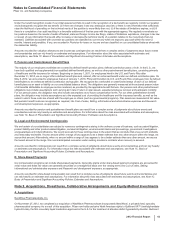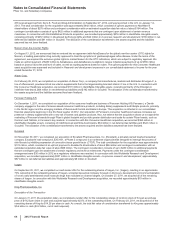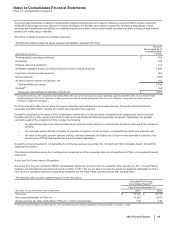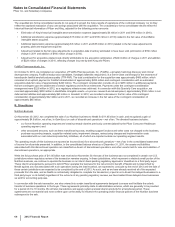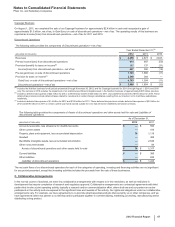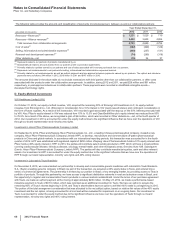Pfizer 2012 Annual Report Download - page 59
Download and view the complete annual report
Please find page 59 of the 2012 Pfizer annual report below. You can navigate through the pages in the report by either clicking on the pages listed below, or by using the keyword search tool below to find specific information within the annual report.
Notes to Consolidated Financial Statements
Pfizer Inc. and Subsidiary Companies
58
2012 Financial Report
Note 1. Basis of Presentation and Significant Accounting Policies
A. Basis of Presentation
The consolidated financial statements include our parent company and all subsidiaries, and are prepared in accordance with accounting
principles generally accepted in the United States of America (U.S. GAAP). The decision whether or not to consolidate an entity requires
consideration of majority voting interests, as well as effective economic or other control over the entity. Typically, we do not seek control by
means other than voting interests. For subsidiaries operating outside the United States (U.S.), the financial information is included as of and
for the year ended November 30 for each year presented. Substantially all unremitted earnings of international subsidiaries are free of legal
and contractual restrictions. All significant transactions among our businesses have been eliminated.
We have made certain reclassification adjustments to conform prior-period amounts to the current presentation, primarily related to certain
inventories (see Note 8. Inventories) and certain investments (see Note 7. Financial Instruments). As of the third quarter of 2012, the Animal
Health and Consumer Healthcare business units are no longer managed as a single operating segment.
Pfizer previously announced its intention to initiate an initial public offering (IPO) of up to a 19.8% stake in Zoetis Inc. (Zoetis), a subsidiary of
Pfizer, and on February 6, 2013, an IPO of Zoetis was completed, pursuant to which we sold 99.015 million shares of Zoetis, which
represented approximately 19.8% of the total outstanding Zoetis shares. For additional information, see Note 19A. Subsequent Events: Zoetis
Debt Offering and Initial Public Offering.
On November 30, 2012, we completed the sale of our Nutrition business to Nestlé and recognized a gain related to the sale of this business in
Gain/(loss) on sale of discontinued operations––net of tax in the consolidated statement of income for the year ended December 31, 2012.
The operating results of this business are reported as Income/(loss) from discontinued operations––net of tax in the consolidated statements
of income for all periods presented. In addition, in the consolidated balance sheet as of December 31, 2011, the assets and liabilities
associated with this business are classified as Assets of discontinued operations and other assets held for sale and Liabilities of discontinued
operations, as appropriate. For additional information, see Note 2B. Acquisitions, Divestitures, Collaborative Arrangements and Equity-Method
Investments: Divestitures. Prior period amounts have been restated.
On August 1, 2011, we completed the sale of our Capsugel business and recognized a gain related to the sale of this business in Gain/(loss)
on sale of discontinued operations––net of tax in the consolidated statement of income for the year ended December 31, 2011. The operating
results of this business are reported as Income/(loss) from discontinued operations––net of tax in the consolidated statements of income for
the years ended December 31, 2011 and 2010. For additional information, see Note 2B. Acquisitions, Divestitures, Collaborative
Arrangements and Equity-Method Investments: Divestitures.
On January 31, 2011, we acquired King Pharmaceuticals, Inc. (King). Commencing from the acquisition date, our financial statements reflect
the assets, liabilities, operating results and cash flows of King, and, in accordance with our domestic and international reporting periods, our
consolidated financial statements for the year ended December 31, 2011 reflect approximately 11 months of King’s U.S. operations and
approximately 10 months of King’s international operations. For additional information, see Note 2A. Acquisitions, Divestitures, Collaborative
Arrangements and Equity-Method Investments: Acquisitions.
B. Adoption of New Accounting Standards
The provisions of the following new accounting and disclosure standards were adopted as of January 1, 2012:
• Presentation of comprehensive income in financial statements. As a result of adopting this new standard, we have presented
separate Consolidated Statements of Comprehensive Income.
• An amendment to the guidelines on the measurement and disclosure of fair value that is consistent between U.S. GAAP and
International Financial Reporting Standards. The adoption of this new standard did not have a significant impact on our financial
statements.
C. Estimates and Assumptions
In preparing the consolidated financial statements, we use certain estimates and assumptions that affect reported amounts and disclosures,
including amounts recorded and disclosed in connection with acquisitions. These estimates and underlying assumptions can impact all
elements of our financial statements. For example, in the consolidated statements of income, estimates are used when accounting for
deductions from revenues (such as rebates, chargebacks, sales returns and sales allowances), determining the cost of inventory that is sold,
allocating cost in the form of depreciation and amortization, and estimating restructuring charges and the impact of contingencies. On the
consolidated balance sheets, estimates are used in determining the valuation and recoverability of assets, such as accounts receivables,
investments, inventories, fixed assets and intangible assets (including acquired in-process research & development (IPR&D) assets and
goodwill), and estimates are used in determining the reported amounts of liabilities, such as taxes payable, benefit obligations, accruals for
contingencies, rebates, chargebacks, sales returns and sales allowances, and restructuring reserves, all of which also impact the consolidated
statements of income.
Our estimates are often based on complex judgments, probabilities and assumptions that we believe to be reasonable but that can be
inherently uncertain and unpredictable. If our estimates and assumptions are not representative of actual outcomes, our results could be
materially impacted.

















